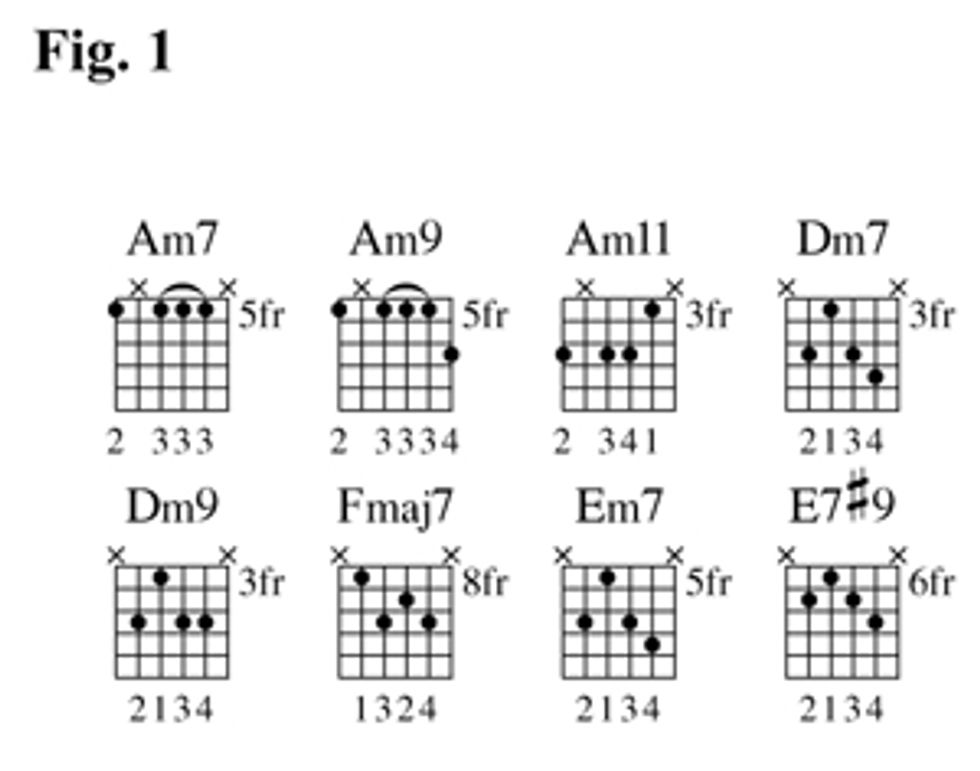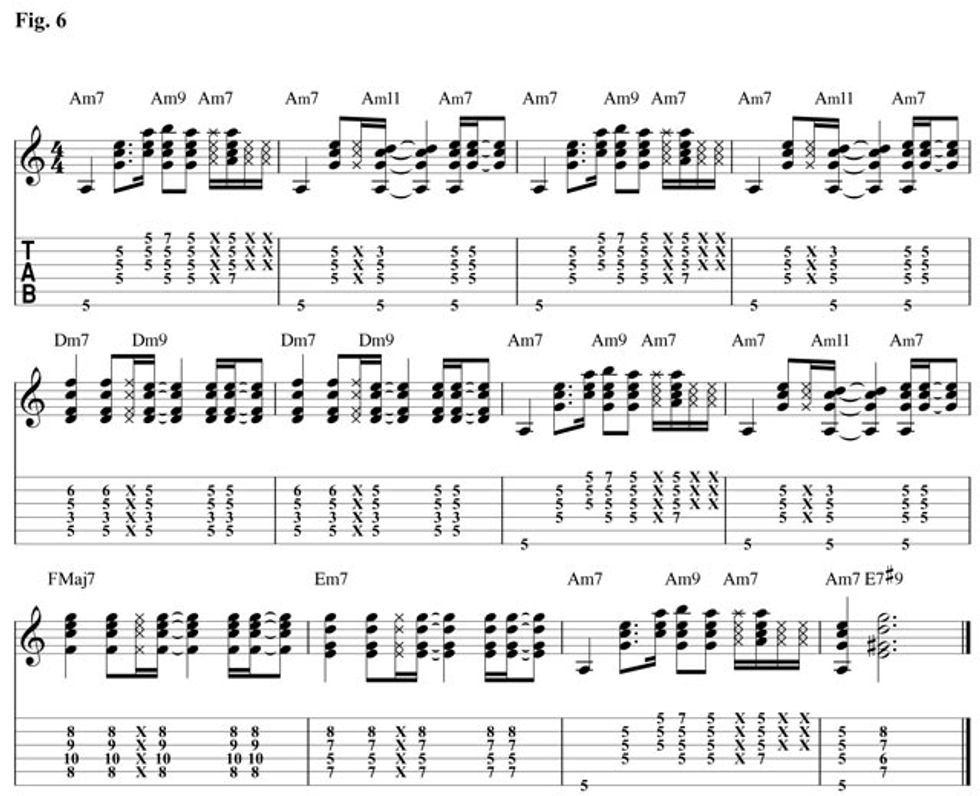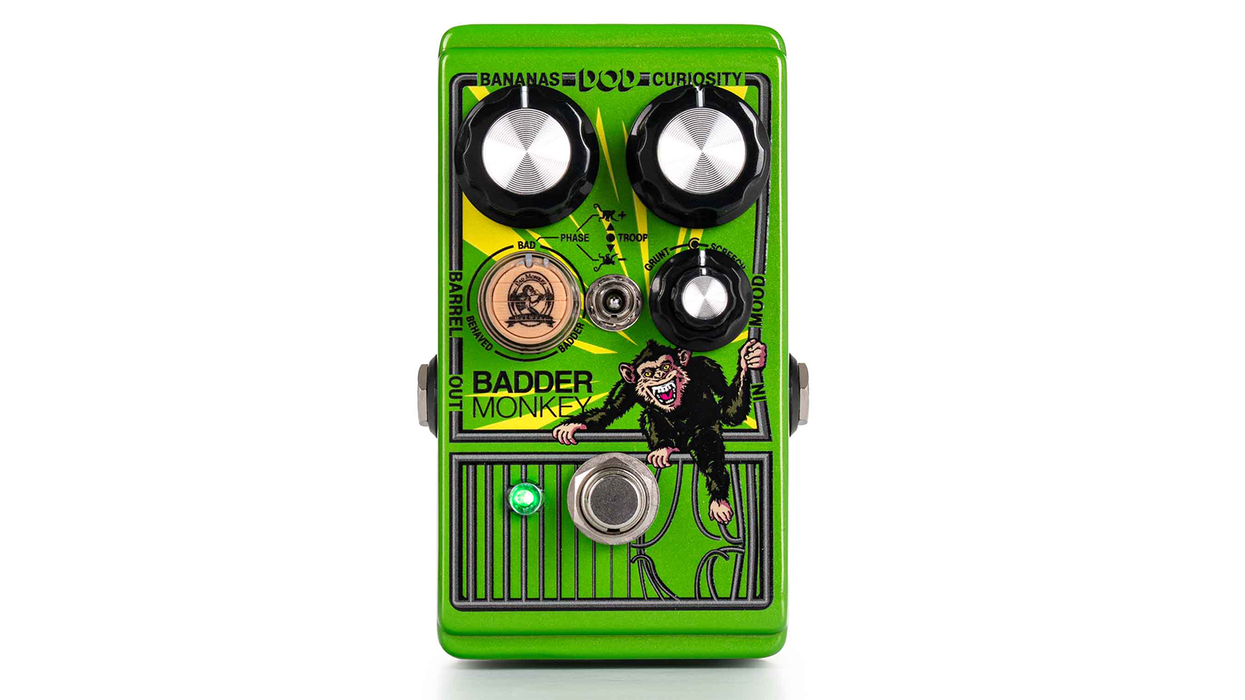| Print it! Click here to download a high-resolution, printable PDF of the notation. |
| Chops: Intermediate Theory: Advanced Beginner Lesson Overview: • Develop voicings for minor 9th and minor 11th chords. • Learn how to comp over a minor blues progression. • Create turnarounds with the VI chord in a minor key. |
Fig. 1 contains the chords we’ll be using throughout this lesson. Some of these you might recognize, others might be completely new. One of the first things I do when I learn a new chord voicing to become familiar with it, is to run it up and down the neck of the guitar from as high as I can to as low as I can and then back where I started. These are all movable forms—since none of them contain open strings—so I would say the name of the chord each time I move up or down. This is a very effective way to become familiar with a new chord voicing.

Fig. 2 is an example of a rhythm that uses both Amin7 and Amin9. These chords are interchangeable, which means anytime you see an Amin7 chord listed you can use an Amin9, and vise versa. The only difference is the added 9th on the top of the chord. I look at these notes as melody notes, so when I play rhythm guitar behind a singer or a soloist I’ll try to play little ideas that enhance the music. I don’t want to get in the way of the music—I want to add to it. I really like to improvise and these chordal ideas give me a chance to be both a rhythm guitarist and an improviser at the same time. What’s cool about this one is how the Amin7 has the root (A) on the top and I get the 9th (B) by simply raising the root up a whole step. When we build our chords we build them in thirds. Then, when we start to add more color choices or upper structures we come back around the scale again and use all the notes we skipped the first time around. So the 2nd becomes the 9th, the 4th scale degree becomes the 11th of our chord, and the 6th becomes the 13th. We can’t use all the notes at the same time, so we have to pick and choose. The rule of thumb is to start out by using the root the 3rd, and the 7th. Then add one or two upper structures like the 9th, and/or the 13th.
Download example 2 audio...

Fig. 3 is a rhythmic idea that moves from Amin7 to an Amin11 chord. The Amin11 is one of my all time favorite chords. It’s a very open sounding chord, not a lot of tensions in this chord, which gives it an almost floating or harp like quality. The minor blues is a cool place to start adding these new upper structures because it typically doesn’t move very fast and you can listen to the way these new chords interact with the other instruments of the band. Notice how the chord movement is on the second string. We start out with the Amin7 with the 5th (E) of the chord being our highest note and then we simply lower it a whole step to (D) which becomes the 11th.
Download example 3 audio...

Fig. 4 is a new way for you to voice a Dmin7 chord that moves seamlessly to a Dmin9 chord. This is such a small movement but makes such a large musical impact. The chord movement here is also on the second string. We move from the b3rd (F) of the Dmin7th chord down a half step to the 9th (E) of the Dmin9.
Download example 4 audio...

Fig. 5 is a cool turnaround for an A minor blues progression. This is similar to “The Thrill Is Gone”. We start with the FMaj7 chord (which is the VI chord of the key of A minor) and then we move to the v chord (Emin7), and then back to Amin7. In the last measure we use an E7#9 to get us back to the top of the progression. E7#9 has a lot of tension and resolves nicely to the Amin7.
Download example 5 audio...

In Fig. 6 we combine all these new chords to work in a minor blues progression. Take your time and work through each of the examples leading up to this one. Take time to listen to how each chord sounds. Are all the notes clear and are you able to hear each note? Also, use this example track to experiment with your own rhythmic ideas with these new chord voicings.
Download example 6 audio...

Try making up your own rhythms and even combining them with a few of these examples. I’ve said before that rhythm guitar is so important and it’s what we really spend the most time doing when playing with others. When you incorporate new chord voicings into your playing it gives it a spark, or a lift that makes it more fun not only for you to play but also for the listener.
 Dennis McCumber has been a guitar instructor and performer
for more than 20 years. He holds a Bachelor’s degree in music
education from The College of Saint Rose.
Dennis performs
regularly in the New York City area with various rock, blues, and funk bands, and occasionally as a classical soloist.
In addition to performing, Dennis has been a middle school
music teacher in the Bronx for the past 12 years. While
teaching in the Bronx, he was given a guitar lab by VH1
Save the Music and a keyboard lab from the radio station
Hot97 Hip Hop Symphony. Dennis has been an instructor at
the National Guitar Workshop since 1996, where he teaches
Blues, Funk, and Rock. Find out more at dennismccumber.com
Dennis McCumber has been a guitar instructor and performer
for more than 20 years. He holds a Bachelor’s degree in music
education from The College of Saint Rose.
Dennis performs
regularly in the New York City area with various rock, blues, and funk bands, and occasionally as a classical soloist.
In addition to performing, Dennis has been a middle school
music teacher in the Bronx for the past 12 years. While
teaching in the Bronx, he was given a guitar lab by VH1
Save the Music and a keyboard lab from the radio station
Hot97 Hip Hop Symphony. Dennis has been an instructor at
the National Guitar Workshop since 1996, where he teaches
Blues, Funk, and Rock. Find out more at dennismccumber.com


![Rig Rundown: Russian Circles’ Mike Sullivan [2025]](https://www.premierguitar.com/media-library/youtube.jpg?id=62303631&width=1245&height=700&quality=70&coordinates=0%2C0%2C0%2C0)





















